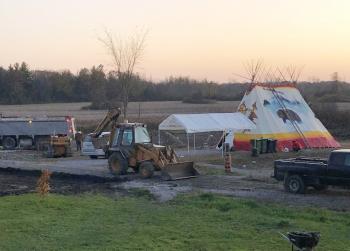Image Caption
Summary
Local Journalism Initiative Reporter
Windspeaker.com
Betsy Kechego’s dream of a place to bring new life and vitality to the culture and spirit of her people at the Chippewa of the Thames First Nation is taking shape.
Kechego and her cousin Crystal Kechego have begun welcoming people into a 22 ft. by 40 ft. tipi in the community near London, Ont. There they hold ceremonies and provide Elders’ teachings that otherwise might be lost to future generations, Betsy tells Windspeaker.com.
Community members and visitors from as far away as British Columbia, the East Coast, and from northern areas —“an amazing gathering of people” — have been flocking to the tipi to attend ceremonies, helping to provide the sense of connection that many have been missing during the months of pandemic lockdown, the community organizer says.
While the tipi is filling a need, the pair are holding on to their original goal, set more than two years ago, of building a traditional Anishinaabe roundhouse to be named the Nimkii Binesi Zaswaaning (Thunderbird’s Nest). It will be a building for her people to “come and practise our culture and our traditions,” said Betsy, also known as Waawaaskone Kiizhigo.
The organizing group has raised more than $60,000 through online art auctions, social media, word of mouth, and a GoFundMe campaign for the project. Inspired by structures other First Nations have erected, Betsy and Crystal envision the roundhouse as a space of learning, healing and growth where people can gather, celebrate, socialize, feel connected to land, and hold traditional ceremonies.
Naming the site for the Thunderbird is “perfect” for her grassroots group, says Betsy, since Thunderbirds “bring renewal and new life.”
While the tipi may help blunt the problems of isolation in the short term, Betsy says it’s also a means to bridge the gap caused by pandemic-related construction delays for the roundhouse.
Work on the permanent structure will start next spring, it is hoped, Betsy says. The land has already been prepared, drainage installed, and a parking lot paved.
With only 10 people allowed to meet due to pandemic gathering limits, Kechego admits “it’s not like how we usually gather,” but that hasn’t stopped the brisk pace of naming ceremonies in the tipi, many of them for members of the Chippewas of the Thames youth group.
The young people are “looking for that connection and their identity” that has been lost in many families due to the effects of colonial policies, such as residential schools. Betsy feels the ceremonies will help youth in their future.
“When you start to identify…(with) who you are, you're a much stronger person,” she says.
The purpose of the centre is “all about everything Indigenous people have been through,” she says. “I know we can fix ourselves. It's a matter of building those social structures and revitalizing and reclaiming our languages, everything that supports our way of doing things,” Betsy explained.
She anticipates many activities at the roundhouse will focus on the teaching of the Ojibwe language Anishinabemowin. With Elders passing on, she fears their knowledge is going with them. The Chippewas of the Thames community no longer has any fluent speakers, and she hopes other adults will take up studying the language along with her.
“Language is where our worldview comes from. It’s very important,” she emphasizes.
Betsy pays tribute to Manitoba Elder Dave Courchene, who passed this December. His visit to Chippewas of the Thames First Nation inspired her to launch the campaign for a roundhouse.
Courchene was involved with building a similar structure, the Manitoba Turtle Lodge, at Fort Alexander, which has been “a centre for events, ceremonies, conferences and gatherings of people from around the world to honour the traditional knowledge of the First Peoples,” according to the lodge website.
Betsy says Courchene encouraged Anishinabe to start building roundhouses “because that was our original gathering place when we wanted to make big decisions about our families and our communities. We would ask for guidance and directions from our Elders and our spiritual connections from our Manidoo (Great Spirit),” she explained.
The structure could also become a place to pursue reconciliation with the settler community. Betsy believes in possibly inviting settler people in as cultural tourists, but “it’s a fine line” ensuring visitors come with open minds and aren’t planning to exploit or appropriate First Nations’ teachings, she says.
“When you think about the medicine wheel, it’s about people coming together and accepting each other in harmony. If you want to make a difference you have to open the door and let people in.”
Inviting all people to the tipi or roundhouse “holds true to what our Elders talked about” in a prophecy of “two roads where people will come together and gather under the sacred tree,” she said.
Her feelings have been deepened by the experience of the pandemic, Betsy said. “It’s more important than ever to accept people as who they are.”
While she is pleased by the amount of money that has been donated — “it’s amazing the support we are getting” — Betsy Kechego says fundraising is continuing to make sure her dream becomes a solid reality.
Local Journalism Initiative Reporters are supported by a financial contribution made by the Government of Canada.

